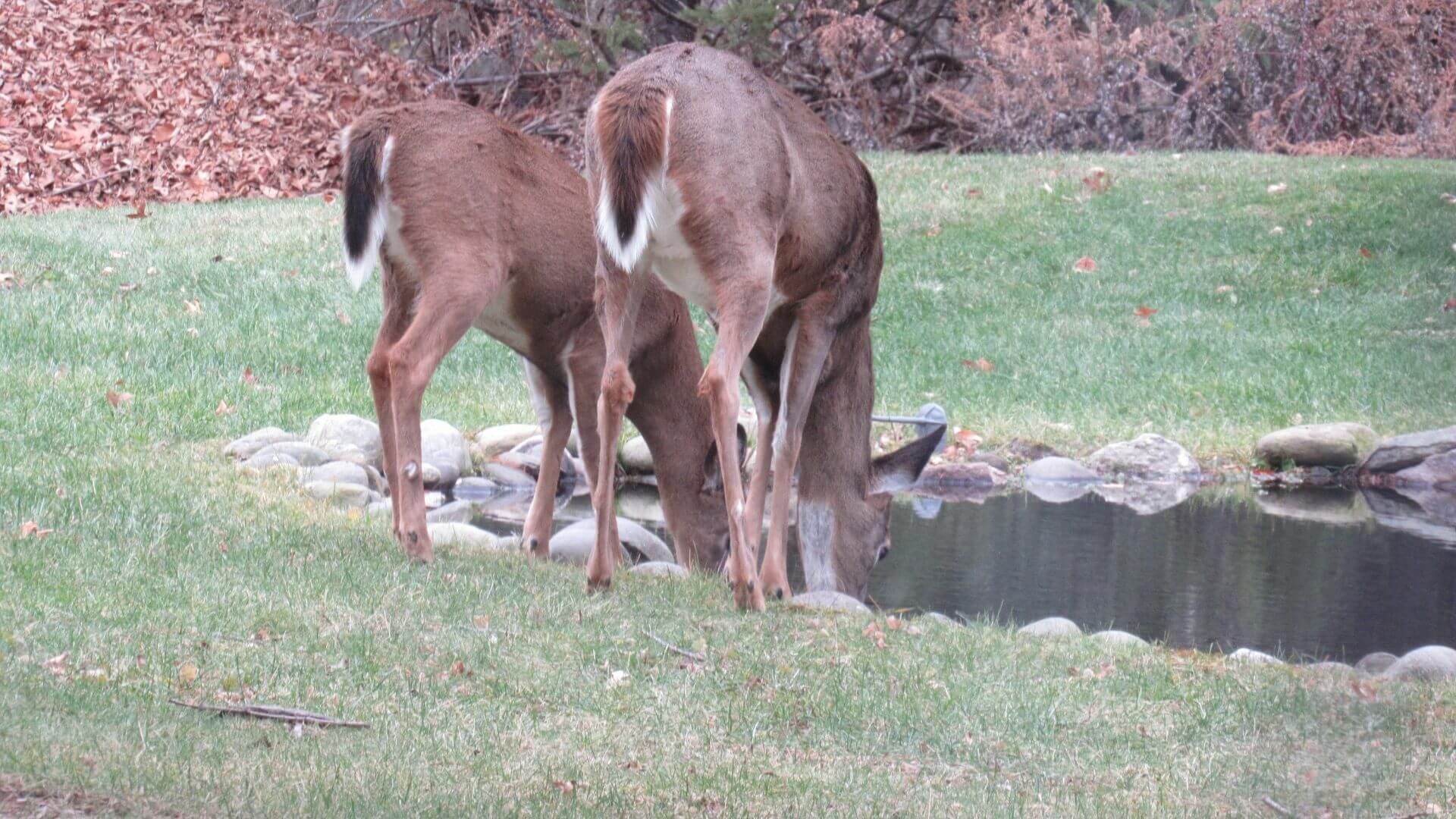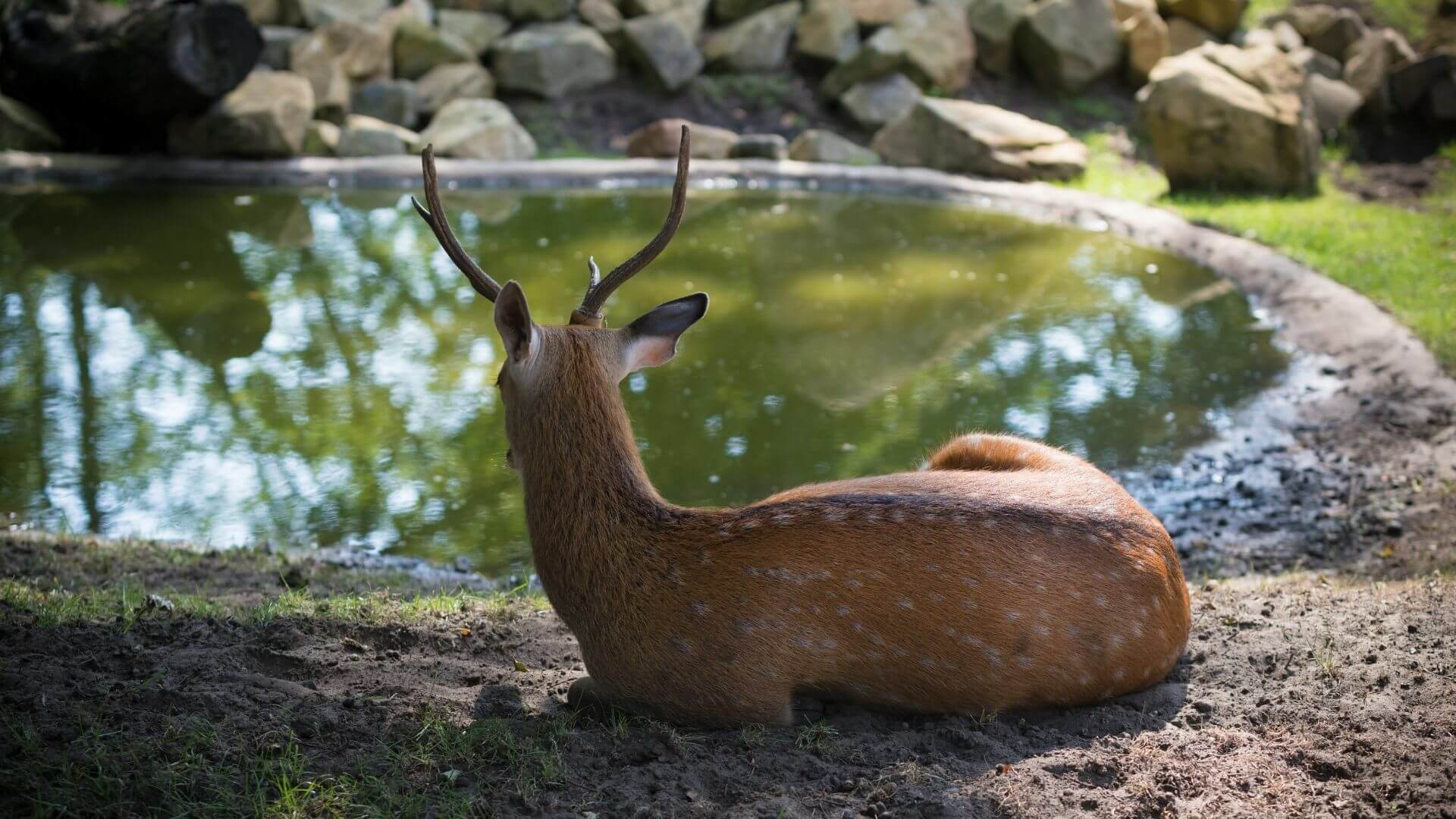Michigan is legendary for its water—lakes, rivers, wetlands—and its whitetail deer thrive in landscapes shaped by abundant moisture. From deep winter snows to dry summer spells, reliable water access is pivotal for deer survival.
On hunting lands, well-designed water features aren’t just wildlife magnets—they elevate habitat, improve hunting success, and significantly boost property value. In this article, we explore Michigan-specific benefits—covering pond types, cost vs. ROI, state regulations, and examples—to help landowners make smart, habitat-enhancing investments.
1. The Importance of Water on Michigan Whitetail Lands

Whitetail deer require approximately 2–3 quarts of water per 100 pounds of body weight each day, depending on season. In winter, especially on Upper Peninsula properties, melting snow may not always be enough to keep deer hydrated. During summer drought, small water sources become essential gathering points.
Michigan’s deer population was estimated at 1.7 million according to Michigan DNR. A stable or growing deer herd increases competition—making reliable water sources even more attractive.
Water draws wildlife year-round and improves biodiversity: ducks, turkeys, frogs, small mammals—all benefit. On deer properties, this not only creates natural food chains but also increases the odds of deer hunting success.
From a management standpoint, the Michigan DNR factors deer-vehicle collision data, hunter harvest, and habitat quality into Deer Management Unit adjustments. A property that proactively improves habitat—especially water sources—can help stabilize deer numbers and improve overall herd health.
2. Michigan-Friendly Water Feature Types & Benefits

a. Natural & Built Ponds
Michigan is home to an estimated 50,000+ farm and wildlife ponds, legacy structures often found on hunting land. Whether natural or excavated, ponds offer:
- Versatile habitat: Fish, amphibians, waterfowl, turkey, and deer.
- Winter refuge: Keeps water open during deep snow.
- Resale value: Rural properties with ponds average $18,130–$18,172 per acre and $570k–$572k listing prices.
National data shows ponds on bare land can increase land value by ~6% on average, with ranges from 0–42%, depending on size. Michigan’s value spike is especially high—prime waterfront tracts can exceed $100,000 per acre.
Design Tips:
- Depth spectrum: Aim for shallow edges (2–4 ft) with deeper central zones (6–10 ft) to support amphibians and fish while ensuring winter water persistence.
- Stocking: Native fish like bluegill can balance insect populations.
- Cover: Plant cattails, willows, shrubs around edges.
b. Stock Tanks & Waterholes
Stock tanks are an affordable fallback when pond construction isn’t viable. Michigan hunters report setting 50-gallon galvanized tanks near bedding areas and see consistent deer visits within weeks .
Advantages:
- Low initial cost (under $500)
- Flexible placement
- Fast setup
Boost effectiveness by placing tanks along deer trails, beneath tree lines, or just downslope from food plots. For winter use, consider submerging rope lights to prevent freezing. Add aerators to reduce algae and mosquito issues.
c. Streams, Creeks & Riparian Buffers
Michigan landowners often own riparian rights along creeks or small rivers. Enhancing buffers pays dividends: improved water quality, erosion control, and thick cover for deer movement .
Benefits:
- Natural corridors: streams act as highways between bedding, food, and water.
- Bank vegetation: hardwoods/shrubs stabilize soil and act as deer bedding cover.
- Regulation: the DEQ/EGLE mandates 500-ft buffers and Part 303 wetland protections—be informed.
Improve buffers by planting native species like willows, dogwoods, and sedges. Allow 50–100 ft of natural vegetation to shield eroding soil and create dense bedding areas. Seasonal trenches off small streams also maintain moisture even in dry months.
d. Pondless Water Features & Fountains
Pondless waterfalls and recirculating fountains offer year-round aeration for small waterholes without wildlife drowning risk. Though more aesthetic, they attract songbirds, turkeys, and small mammals—boosting habitat appeal and water quality via oxygenation and circulation .
Key elements: incorporate rock cascades, recirculating pumps, and rock-lined basins with planted moss. These whispering water features create hunting ambiances and subtle cover.
3. Regulations & Legal Considerations in Michigan

Riparian & Groundwater Law
Michigan’s riparian doctrine grants water use for landowners whose property borders watercourses—creeks, lakes, springs . However, significant modifications often require permits.
Key Regulations:
- DEQ/EGLE: Earthworks that excavate >500 cubic yards or install dams/ponds >15 ft high or >five acres require permits .
- Part 303 Wetlands Protection: No permits for drains or incidental modifications in regulated wetlands.
- DEQ Floodplain Permits: Needed in designated flood zones.
Hunting & Baiting Laws
Michigan prohibits baiting deer except during firearm season in designated DMUs. Using waterholes with feed additions is considered baiting—avoid mixing. Make sure water sources comply with Michigan DNR baiting rules .
Local Zoning and Township Rules
Many townships—especially in the UP and Northern Michigan—have additional zoning codes on pond construction and shoreline setbacks. Always check with your township before starting.
4. ROI: Value Analysis for Michigan Hunting Properties
Resale Premiums
- Farm properties with ponds generally price $570k+, with listing per-acre prices near $18k.
- Waterfront lots in mid-lakes areas often exceed $100,000/acre.
- Ponds can increase land values by ~6%, ranging higher in small tracts.
- Nationwide reviews show land adjacent to water sells for up to 90% higher than non-waterfront land.
Hunting Income
Landowners leasing hunting property can charge more for water-enhanced ground—lid their lease rates by increasing wildlife density and engagement.
Cost Breakdown
- Stock tank: $300–$800 installed (tanks, plumbing, pedestal)
- Small pond: $5k–$15k depending on size and excavation
- Large pond: $15k–$50k+, depending on acres and engineering
Even a DIY stock tank often pays off within a single lease season through improved deer sightings and repeat leases.
Tax/Appraisal
Water features typically increase scored value on assessment models—often resulting in higher property taxes. However, increased sale prices usually offset this over time.
5. Best Practices: Design & Maintenance
Strategic Placement
- Place troughs and ponds along deer trails between bedding and feeding sites.
- Install wind blocks (brush piles, evergreens) to create shelter near water.
Winter Prep
Insulate stock tanks or use thermostatically controlled heaters. Anchor pond liners to prevent freeze damage.
Aquatic Plantings
Use native Michigan species like cattails, sedges, willows, sweet flag, and dogwoods to create shore cover and stabilize banks.
Maintenance Tips
- Use mosquito dunks (BTI) in tanks and ponds.
- Monitor phosphate to prevent algae blooms.
- Schedule spring cleanups for debris and sediment removal.
6. Michigan Case Studies
Upper Peninsula Stock Tank
An UP landowner installed a 50-gallon tank in a bedding pocket. Within six weeks, trail cameras recorded deer visits from November to March—even during deep snow.
West Michigan Pond Lease Success
A 40-acre property in Mecosta County built a half-acre pond near timber bedding. Lease revenue increased 30%, as hunters reported more frequent deer sightings.
7. Conclusion: Actionable Next Steps
Water features offer clear benefits: improved deer access, year-round wildlife habitat, enhanced property aesthetics, and significant ROI.
Checklist:
- Assess natural water availability and wildlife movement.
- Choose between stock tank, pond, stream enhancement, or pondless device.
- Consult with EGLE/DNR to confirm permits.
- Position feature near known deer trails, with shelter and habitat plantings.
- Install appropriately sized water source.
- Maintain through seasons using heaters, dunks, and cleanup.
Start small—stock tanks are inexpensive and fast. As deer use increases, move up to ponds or stream buffer improvements to further elevate wildlife value and hunting returns.
Michigan-Specific FAQs
Do I need EGLE permission for a pond?
Yes: excavations >500 cubic yards or creating >15 ft dams require permits. Part 303 wetlands also involve extra oversight .
Can stock tanks count as baiting?
Only if feed or attractants are added. Clear water troughs are legal even during restricted seasons.
Are stream enhancements legal?
Yes, as long as you own riparian rights and follow DEQ buffer, floodplain, and wetland rules.
Will a pond hurt my taxes?
Potentially—assessments may rise—but increased sale price usually outweighs extra tax.
Final Thoughts
For Michigan whitetail property owners, water is habitat currency. From budget-friendly stock tanks to large, bespoke ponds, these features draw deer, support healthy herds, and significantly boost property valuations. With smart placement, legal compliance, and seasonal